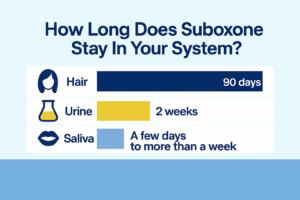How Long Does Suboxone Stay in Your System?
Suboxone, a combination of buprenorphine and naloxone, is a semisynthetic opioid primarily used to treat addiction to other opioids, such as heroin and hydrocodone. It was developed as an alternative to methadone, which is another medication used for treating opioid use disorder (MOUD).
Though still opioids, methadone and buprenorphine don’t create the same intense high as illicit and commonly misused prescription opioids. They can therefore reduce or eliminate withdrawal symptoms and cravings, but they aren’t as addictive or desirable.
So, how long does Suboxone/buprenorphine stay in your system? Continue reading to learn more, and to find out about Suboxone half-life and metabolism, factors influencing how long Suboxone stays in your system, and how to find compassionate addiction treatment near you.
Suboxone Half-Life & Metabolism
The buprenorphine in Suboxone has an especially long elimination half-life compared to other opioids. Elimination half-life refers to the amount of time it takes for half of a single dose of a drug to leave the body. For buprenorphine, this period lasts for 37 hours, meaning that it can take over 8 days for Suboxone to no longer be detectable in a person’s body.1
How Long Is Suboxone In Your System?: Detection & Drug Tests
When referring to timelines for how long Suboxone stays in your system, this is different for everyone, and only general information can be provided. The process of metabolizing Suboxone in the liver creates metabolites that tend to stay in the body for longer than the drug itself. Modern drug tests can detect these as well, so even after 8 days, an individual might still produce a positive test for buprenorphine.

Blood tests are invasive but can detect substances shortly after ingestion; however, they also have a smaller window to detect buprenorphine. The best time for a blood test to work is a little over 2 hours after the last dose.
In terms of Suboxone’s presence in hair, urine, and saliva tests:
- Hair tests are not a very reliable form of drug testing, however, Suboxone and its metabolites can build up in hair follicles and can be detected in hair tests for 1-3 months.
- Urine tests are the most commonly used, especially by employers. Buprenorphine will become detectable in the urine just 40 minutes after consumption, and for long-term, heavy users, the drug will show up in these tests for up to 2 weeks later.
- Saliva tests are used more often because they’re noninvasive and simple to administer. These tests can work for a few days or possibly more than a week after the last dose of Suboxone.
If you are concerned about your Suboxone usage, or are looking for treatment support, reach out to American Addiction Centers (AAC) today at
Our admissions navigators can talk to you about your personalized treatment plan, the rehab admissions process, or verify your health insurance benefits. Call today!
Factors Influencing How Long Suboxone Stays in Your System
This period of time is not the same for everyone. There are a number of factors that influence how quickly Suboxone will be flushed out of the system. These include:
- Body fat content.
- Weight and height.
- Age.
- Metabolism speed.
- Size of the last dose taken.
- Amount of time the misuse has gone on.
- Liver health.
